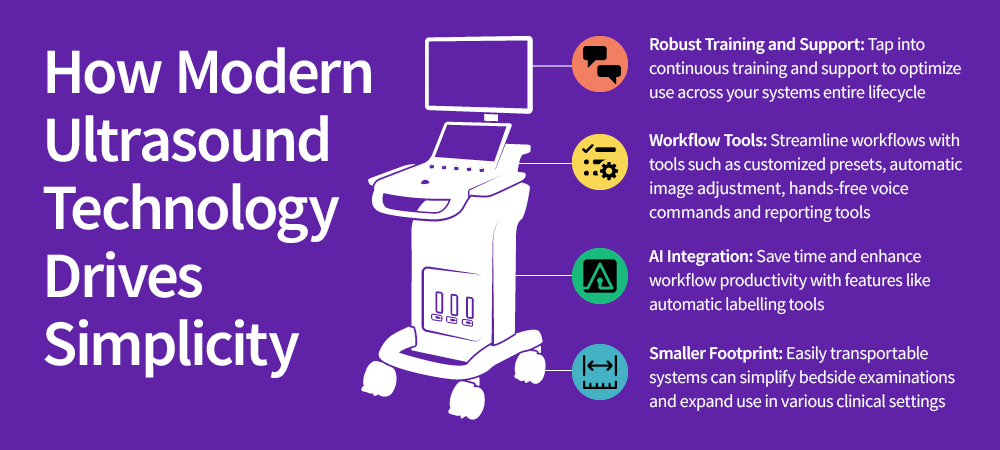Clinician burnout is one of the most pervasive trends currently impacting healthcare. The crisis stems from multiple factors, including but not limited to extreme workload, impossible time constraints, difficulty navigating equipment and infrastructure issues, budget constraints, and much more. Data from GE HealthCare's 2023 Reimagining Better Health Survey indicates that 42% of clinicians surveyed are actively considering leaving the healthcare industry. Additionally, 44% do not feel fully appreciated by patients and patients' families, and 39% do not feel a sense of pride in their profession.1
Perhaps most importantly, these factors reinforce the feelings among dissatisfied clinicians that they aren't doing enough for their patients. Many doctors don't feel like they can perform to their full potential, given the extreme limitations and barriers associated with their everyday work experience. As passion erodes and frustration persists, this burnout is creating a national and potentially global shortage of quality physicians and leaving patients vulnerable to more adverse health outcomes.2
While this problem isn't going to be fixed by any one magical solution, part of the journey forward must include the integration of more versatile and user-friendly equipment, including ultrasound systems. Let's take a look at how a more versatile ultrasound system can reduce daily and long-term physician stress and dissatisfaction.
1. Ultrasound gives general practitioners the opportunity to do more for their patients
Primary care physicians are consistently looking to do more for their patients, but factors like budget, space issues, and learning curves can often get in the way. One of the most alarming revelations of the above survey findings is that 44% of clinicians say they cannot work to the full extent of their training and/or education in their organizations.
A more versatile ultrasound system can help practices quickly and effectively increase their scope of treatment by taking the diagnostic reins that were previously held by specialists and radiologists. The right system can help even first-time users deftly and confidently integrate ultrasound into their practice so they can take even more of an active role in their patients' diagnoses and offer a more seamless path to care.
Current ultrasound technology includes specific probes that can be utilized for quick, convenient, and confident scanning of specific parts of the anatomy. It also offers specialized software packages and productivity tools for designated body parts, like the abdomen, breasts, thyroid, and others, that allow primary care physicians to diagnose more conditions than ever before.3
2. Personnel and space: the right ultrasound system can help minimize your equipment footprint and maximize staff productivity
There are three things that every healthcare facility wishes it had more of: space, people, and money. Part of the source of physician burnout is resource limitation, which, at least in some part, can be relieved by a more versatile ultrasound system.
To save space, there are current systems that are built for maximum portability and convenience so doctors can easily maneuver them from patient to patient. Rather than dedicate valuable square footage to diagnostic equipment, many systems can be wheeled in and out of where they're needed, and some can even be carried by doctors just like they do a briefcase or laptop.
A more versatile system can also help reduce the manual clinical and administrative effort previously required by older systems. On a clinical level, tools like needle recognition, intuitive color adjustment, image tuning, hands-free voice commands, and much further empower even novice users to perform scans with minimal assistance.
On an administrative level, AI-enabled and automated functions like labeling, image and record storage, and data capture can be achieved with little to no human effort, freeing your staff up to perform other essential duties. It's also worth noting that bringing ultrasound in-house for general practitioners significantly reduces the time their front-of-office staff spends navigating the referral process and coordinating specialist appointments for outgoing patients.
On both levels, longer-than-ever battery life, wireless capability, and ergonomically focused design make life easier for everyone. Finally, and perhaps most importantly to many smaller practices with limited budgets, there are flexible and versatile financing options that allow you to immediately reap the benefits of ultrasound integration without having to allocate large blocks of funds all at once.
3. Flattening the learning and maintenance curves
Doctors who are experiencing clinician burnout commonly cite equipment issues and lack of training or time to learn new systems as primary causes.1 The reality is that technology is often implemented in healthcare organizations with very little time for clinical staff to master it, leading to the need for compulsory "on-the-job" training and inevitable frustrations and delays in patient care.
Physicians need and deserve the opportunity to continuously increase their education and skill set in ways that will keep them fulfilled and help their patients. According to the survey, over 45% of clinicians say they do not receive adequate training on how to use available medical technology to its full potential. Clinicians want new skills to stay ahead of the curve. A versatile ultrasound system not only helps them easily enrich their education independently but provides next-level support, training, and guidance for maximum confidence in operability. These systems also offer detailed guidance when it comes time to upgrade, perform service or maintenance, or install new software. In short, they provide a user-friendly experience with an extra layer of training and education to ensure optimal use.
A little help goes a long way
Physicians don't follow a career path; they answer a calling. Their satisfaction and stress levels are generally dictated by thousands of daily experiences over the course of their careers. Little by little, these experiences can either strengthen or erode their fulfillment and passion. Whether a practice is just starting to integrate ultrasound care into its scope of care or clinicians are seeking to upgrade their current systems, a more versatile ultrasound can help alleviate clinician burnout and, as a result, enrich the treatment experience for medical professionals and the patients who depend on them for care.
Reliable, affordable, easy-to-use and versatile, Versana ultrasound systems have a variety of automation features, intuitive controls, and budget-friendly options to best meet patient needs.
REFERENCES:
1. Reimagining better health. GE HealthCare. https://www.gehealthcare.com/insights/reimagining-better-health
2. American Medical Association. AMA president sounds alarm on national physician shortage. https://www.ama-assn.org/press-center/press-releases/ama-president-sounds-alarm-national-physician-shortage. [October 25, 2023]
3. Versana Primary Care Ultrasound Systems. GE HealthCare. https://www.gehealthcare.com/products/ultrasound/versana




